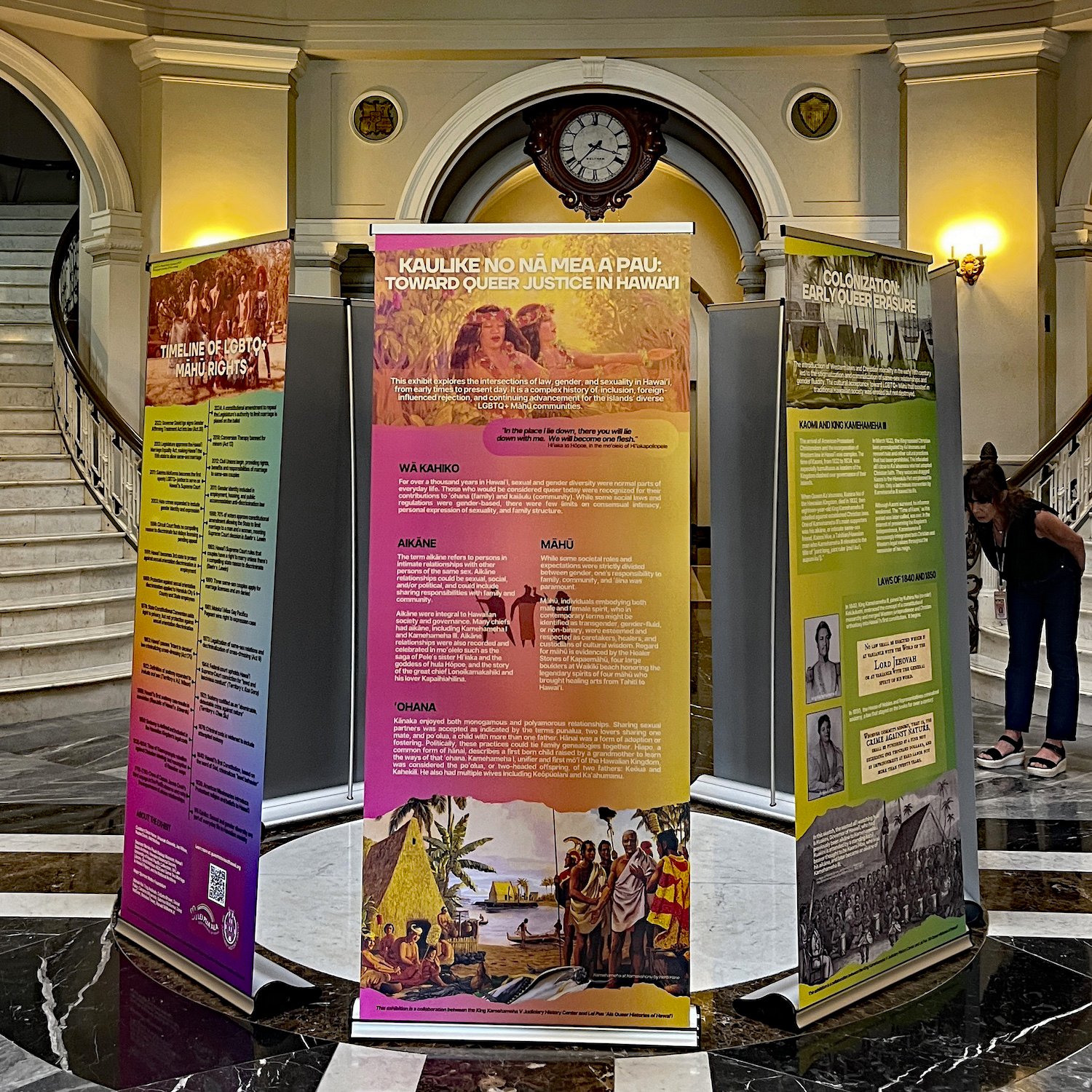
On October 1, 2024, Lei Pua ʻAla Queer Histories of Hawaiʻi and King Kamehameha V Judiciary History Center launched a new traveling exhibition that explores the intersections of law, gender, and sexuality in Hawaiʻi. The exhibition, free and open to the public, is on display daily throughout October and November in the rotunda of Aliʻiolani Hale, home of the Hawaiʻi Supreme Court.
Titled “Kaulike No Nā Mea A Pau: Toward Queer Justice in Hawaiʻi,” the exhibition highlights the complex ways in which gender and sexual diversity has been treated in the evolving social, political, and legal landscape of the islands, from early times to the present day. It features little-known stories and pivotal moments that reveal highs and lows across the centuries, from Hawaiian cultural embrace of māhū (individuals of dual male and female spirit) and aikāne (intimate friends of the same-sex) to missionary condemnation and colonial erasure, from plantation- and military-era persecution and criminalization to the emergence of gay liberation and the modern movement for dignity, respect, and civil rights for all.
“Hawaiʻi is well known as the birthplace of marriage equality,” said exhibition curator and Lei Pua ʻAla Co-Director Dean Hamer. “But few appreciate the foresight, strategy, and courage required to build support and enshrine protections for gender and sexual diversity in law. We hope this exhibition will deepen public understanding of how LGBTQ+ rights are part of the larger legal framework that ensures the promise of justice for everyone.
Matt Mattice, Executive Director of the Judiciary History Center and co-curator of the exhibition said “this exhibit highlights the continued influence of Native Hawaiian culture on contemporary public policy in Hawaiʻi. Partnering with Lei Pua ʻAla reminds us that community organizations play a strategic role in museum programming.”
The unveiling of the exhibition marked the beginning of Honolulu Pride Month with a panel discussion that featured Supreme Court Associate Justice Sabrina McKenna, former Associate Justice Steven Levinson, and attorney and former Associate Judge Daniel Foley discussing the groundbreaking 1993 same-sex marriage decision Baehr v. Lewin.
The exhibition is available to libraries, schools, courts, and other civic institutions in Hawaiʻi interested in being a temporary host site. The exhibition panels can be previewed below and as an online exhibit on the Judiciary History Center website.
Display: Eight mobile, retractable vinyl banners, 33” w x 81” h (pictured below)
Traveling Exhibition Host Site Inquiries: Joe Wilson, Co-curator and Lei Pua ‘Ala Queer Histories of Hawai’i Director - E: qwavesjoe@yahoo.com | T : 808-629-9864
Kaulike No Nā Mea A Pau: Toward Queer Justice in Hawaiʻi (Virtual Discussion)
The virtual talk story below was recorded live Monday, November 25, 2024, featuring distinguished guests: Maui attorney Lance D. Collins, Kanaka Maoli historian Adam Keawe Manalo-Camp, Molokaʻi attorney Karen M. Holt, and Co-Director of Lei Pua ʻAla Queer Histories of Hawaiʻi Dean Hamer, who is also co-curator of the new exhibit.
The discussion explores Hawaiʻi’s complex history of gender and sexual diversity, and what factors are at the root of Hawaiʻi’s inclusive stance on gender and sexuality today. Learn about Mōʻī Kamehameha III's male partner, Kaomi. Together, they co-ruled in a bold resistance to missionary hegemony in a brief yet significant chapter in Hawaiian history known as "the time of Kaomi." And landmark legal battles, such as the Miss Gay Molokaʻi Pageant in 1985, will highlight social backlash and legal responses to issues of sex, gender, and identity expression across the islands.









